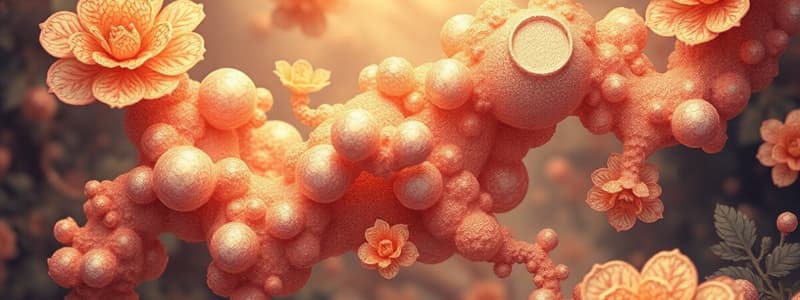Podcast
Questions and Answers
Triglycerides are primarily utilized for short-term energy storage in animals and plants.
Triglycerides are primarily utilized for short-term energy storage in animals and plants.
False (B)
Phospholipids contribute to the structural integrity and fluidity of cell membranes.
Phospholipids contribute to the structural integrity and fluidity of cell membranes.
True (A)
Cholesterol serves as a precursor for the synthesis of steroid hormones.
Cholesterol serves as a precursor for the synthesis of steroid hormones.
True (A)
Waxes are primarily involved in signaling within nerve cells.
Waxes are primarily involved in signaling within nerve cells.
Glycolipids are primarily responsible for energy storage in plants.
Glycolipids are primarily responsible for energy storage in plants.
Lipids serve primarily as a source of thermal insulation and cushioning for organs.
Lipids serve primarily as a source of thermal insulation and cushioning for organs.
Pancreatic lipase is the primary enzyme responsible for lipid digestion in the small intestine.
Pancreatic lipase is the primary enzyme responsible for lipid digestion in the small intestine.
Chylomicrons are formed in the stomach and directly enter the bloodstream.
Chylomicrons are formed in the stomach and directly enter the bloodstream.
The main function of VLDL is to transport exogenous triglycerides from the intestine.
The main function of VLDL is to transport exogenous triglycerides from the intestine.
Lipoprotein Lipase (LPL) hydrolyzes triglycerides in chylomicrons into monoglycerides and free fatty acids.
Lipoprotein Lipase (LPL) hydrolyzes triglycerides in chylomicrons into monoglycerides and free fatty acids.
Flashcards are hidden until you start studying
Study Notes
Overview of Lipids
- Lipids are hydrophobic or amphiphilic molecules, mainly soluble in nonpolar solvents but insoluble in water.
- Essential functions include energy storage, cell membrane structure, and cell signaling.
Classification of Lipids
-
Triglycerides (Triacylglycerols):
- Structure: Glycerol backbone + three fatty acids.
- Function: Primary energy storage form in animals and plants; stored as adipose tissue.
-
Phospholipids:
- Structure: Glycerol backbone + two fatty acids + phosphate group with polar head.
- Function: Key components of cell membranes, forming lipid bilayers; contributes to membrane fluidity.
-
Steroids:
- Structure: Four fused carbon rings.
- Function: Includes cholesterol, which is a precursor for steroid hormones, bile acids, and vitamin D; stabilizes cell membranes.
-
Glycolipids:
- Structure: Glycerol backbone + one or more fatty acids + carbohydrate group.
- Function: Present in cell membranes, aiding in cell recognition and communication.
-
Waxes:
- Structure: Long-chain fatty acids linked to long-chain alcohols.
- Function: Provide protective barriers in plants and animals.
-
Sphingolipids:
- Structure: Based on sphingosine with one fatty acid and various polar head groups.
- Function: Involved in signaling and recognition in nerve and immune cells.
Functions of Lipids
- Store kinetic energy as triglycerides.
- Provide structural integrity to cell membranes via phospholipids and cholesterol.
- Act as signaling molecules, regulating physiological processes.
- Offer insulation and protection through adipose tissue and other lipid forms.
Dietary Lipids
- Comprised of triglycerides, phospholipids, and cholesterol, crucial for energy, membrane structure, and hormone synthesis.
Digestion and Absorption of Dietary Lipids
-
Digestion:
- Initiated by lingual lipase in the mouth; gastric lipase in the stomach; and primarily by pancreatic lipase in the small intestine, aided by bile acids.
-
Absorption:
- Formation of micelles allows absorption in the intestinal mucosa; triglycerides are reassembled in enterocytes and then packaged into chylomicrons for transport into the bloodstream.
Lipid Transport and Metabolism
-
Chylomicrons:
- Transport dietary lipids from intestines to tissues; hydrolyzed by lipoprotein lipase (LPL) to release fatty acids.
-
Very Low-Density Lipoprotein (VLDL):
- Transports endogenous triglycerides from liver to tissues; also hydrolyzed by LPL.
-
Intermediate-Density Lipoprotein (IDL):
- Formed from VLDL post triglyceride removal.
Integration with Metabolic Pathways
- Lipid metabolism is interconnected with carbohydrate and protein metabolism, influencing energy balance.
Fatty Acid and Triacylglycerol Metabolism
-
Fatty Acid Synthesis:
- Occurs in liver/adipose tissue; initiated from acetyl-CoA via acetyl-CoA carboxylase and the fatty acid synthase complex.
-
Fatty Acid Oxidation:
- Occurs in mitochondria; fatty acids are converted to acetyl-CoA through β-oxidation.
Triacylglycerol Metabolism
-
Synthesis:
- Glycerol-3-phosphate forms from glucose; fatty acids are added, catalyzed by diacylglycerol acyltransferase.
-
Breakdown:
- Hydrolysis by hormone-sensitive lipase releases fatty acids into the bloodstream for energy.
Ketone Body Metabolism
-
Production:
- Occurs in liver mitochondria during fasting or low carb; involves ketogenesis from fatty acids.
-
Utilization:
- Ketone bodies are converted back to acetyl-CoA in peripheral tissues for energy.
Regulation of Lipid Metabolism
-
Insulin:
- Promotes fatty acid synthesis and triacylglycerol production; inhibits lipolysis.
-
Glucagon and Epinephrine:
- Stimulate lipolysis and ketogenesis during fasting.
-
AMPK Activation:
- Inhibits fatty acid synthesis and promotes β-oxidation during energy stress.
Clinical Relevance
- Metabolic Disorders: Conditions like type 2 diabetes and obesity can disrupt lipid metabolism.
- Ketosis: Can occur during fasting; excessive ketosis risks ketoacidosis.
- Fatty Liver Disease: Accumulation of lipids in the liver due to insulin resistance or high alcohol intake leading to non-alcoholic fatty liver disease (NAFLD).
Phospholipid, Glycosphingolipid, and Eicosanoid Metabolism
-
Phospholipid Synthesis:
- Includes phosphatidylcholine, phosphatidylinositol, and phosphatidylethanolamine, crucial for cell membranes and signaling.
-
Degradation of Phospholipids:
- Hydrolyzed by phospholipases (e.g., PLA2, PLC, PLD), participating in various signaling pathways.
-
Glycosphingolipid Synthesis:
- Involves sphingosine backbone with added sugar residues for cell recognition and membrane integrity.
Studying That Suits You
Use AI to generate personalized quizzes and flashcards to suit your learning preferences.




